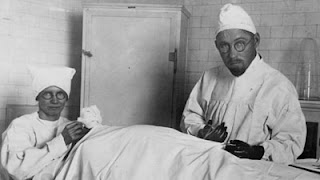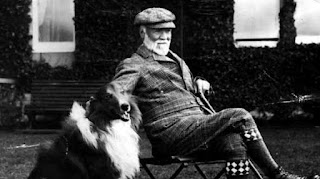Mass Market Mantics
"Millionaires don't have astrologers. Billionaires do."-- financier John Pierpont Morgan, (unverified comment attributed to Morgan in a May 3,1988 San Jose Mercury article by astrologer Sidney Omarr)
Zolar had a secret identity...
 |
| Zolar's Secret Identity: Bruce King |
This secret identity lived in a world where every new day seemed to bring new scientific discoveries on frontiers of knowledge scarcely imagined a few decades earlier. It worked in a city whose movie industry had begun to explore supernatural and magical themes, producing black and white tales of curses stretching from the Egypt of the Pharaohs to modern day London, of men turned into wolves by the power of the moon, of cackling maniacs exulting as lightning flashes reanimated the dead. It helped revive interest in ancient sciences rejected by modern science...
But it also lived in a world of grim realities. Millions of people struggled to find work, many standing in long lines at food kitchens for a hot meal with a sermon for dessert. Men who had believed in certainties found uncertainty was the new rule. In 1932, the Great Depression gripped the nation when Bruce King, a still successful securities salesman, decided the country needed a strong but inexpensive dose of hope. And it didn't hurt this elixir might make him a bit richer...
 |
| Venus in Scorpio... a passionate lover who craves a life of luxury |
King, born in 1897 in the Windy City aka Chicago aka Hog Butcher to the World, briefly tried his hand at acting. This career path wasn't in the stars for the man who combined "Zodiac" and "Solar" to create a professional name but it did bring him to Los Angeles where he became part owner of a radio station whose manager, a chap named Kobar, cast horoscopes. Kobar, it seemed to King, had an uncanny knack for making the right business moves at precisely the right moment. As fate or synchronicity or astral destiny would have it, King met a second astrologer in the same week Kobar left the station to pursue other opportunities. The two men conjured up an "Astrograph" machine which they marketed to movie houses. It worked like a weight machine. Drop a dime in the slot, out pops a slip of paper, not with a reminder to go on a diet, but with tailor-made advice from the Sun, Moon, and Planets. Theater owners nationwide liked the novel idea. Even more, they liked their cut of the profits...
 |
Pretty girls gather around a 1950s Horoscope Machine for
advice on meeting the perfect millionaire and husband |
The erstwhile stockbroker became fascinated by the product he sold. He dove into the study of astrology, learning to cast horoscopes and discern patterns of planetary influences denied by modern science. Now Zolar, King started a publishing company devoted to mantic arts. The core of his business may have been mass market horoscope magazines for uncritical audiences, but Zolar took his subject seriously, penning a number of volumes devoted to the theory and history of occult subjects. A personal favorite of mine, published two years prior to King's death in 1972, was the enticingly titled Encyclopedia of Ancient and Forbidden Knowledge...
Vast numbers of scientists puzzle over the enduring appeal of astrology. It fails a basic test. Predictions do not always come true. Physicists and chemists operate in a world where water boils and freezes at a certain temperature. A scientist with a Bunsen burner and an ounce of H2O in Russia achieves the same result as a scientist with the same items in Scotland, Malaysia or Kansas. Oft heard is the lament more people know their sun sign than know the distance from the earth to the sun...
Bruce King's successful career over five decades as a mass market seer was only one of many careers moving astrology from the province inhabited by muttering old ladies and cranky old men to a world of well-dressed persons and fashionable drawing rooms. Perhaps, if there is something to the notion that seances allow us to chat with the dearly departed, scientists may find answers as to how and why this happened by communing with the shade of Carroll Righter...
 |
| Carroll Righter: Adviser to Presidents |
"Pappy" Righter passed away at age 88 in 1988. He started out, so he told the millions who read his column, as a skeptic who did not believe in mumbo-jumbo dating back to Sumerian times. Righter revised traditional astrology to make it palatable to modern folk, much the same way Walt Disney glossed over grisly details in a Grimmer version of Snow White to create a lovely young lady who sang to cheerful bluebirds and happy dwarves. One of Pappy's revisions was to use the term "Moon Children" when talking about those born under the sign of Cancer the Crab, to avoid subconscious association with dreaded diseases. Righter also moved easily among money and power, building a clientele with a well-oiled publicity machine which included actor Robert Mitchum before the future Hollywood tough-guy moved to star roles of a different kind. The California State Legislature proclaimed "the Gregarious Aquarius" to be the Twentieth Century's most influential astrologer...
A graduate of the University of Pennsylvania Law School, Righter had a lucrative legal practice advocating for the genteel social class of Philadelphia. One account has it he moved to the West Coast for health reasons. Another version says he became friends with the astrologer Evangeline Adams, a descendant of two Presidents by her own account, who advised he relocate. Her client list included J P Morgan, perhaps the most powerful financier in American history. Others visiting her studio at Carnegie Hall included King Edward VII, actress Mary Pickford, and opera singer Enrico Caruso who reportedly would not cross the Atlantic unless Adams assured him the stars were favorable for an ocean voyage...
 |
Linda Goodman's 1968 bestseller revived mass
market interest in the solar astrology practiced
Zolar and Carroll Righter and became an almost
indespensible home accessory for New Agers |
John Pierpont Morgan probably did not actually say billionaires had astrologers but he likely thought along those lines. Students of late 19th and early 20th Century American history are hard-pressed to find a single individual who shaped the economic landscape of his time as much or as powerfully as did Morgan. As a financier, he arranged for the mergers creating General Electric and US Steel and essentially controlled the nation's railway system through a series of interlocking directorates. Hints of the magnitude of Morgan's impact can be seen in the fact that flags flew at half-staff on Wall Street on the day of his funeral...
 |
J P Morgan, financier and architect of the Industrial
Age, for whom Wall Street flags flew at half-staff |
Of Morgan's devotion to astrology and his astrologer, there is little doubt. Evangeline Adams flat out told him NOT to board the Titanic under any circumstance. It was one of the few times in his life that the devout Episcopalian and founder of the Metropolitan Club did not later regret being told what to do. Morgan regularly had Adams compare his birth chart with those of corporations he considered financing to determine the best time for business deals. When Adams was arrested in 1911, charged with violating fortune-telling ordinances, he directed one of New York's leading defense attorneys to represent her...
Adams, incidentally, dressed up as a gypsy and sprinkled shiny powder on her clients in the early days of her career. It is difficult to know the truth of her early life since most of the information we have on the subject comes from one source-- her autobiography. She claimed to have been born to an upper class family several months after her father suffered terrible business losses which placed his daughter in the uncomfortable position of having to go to work at an early age. Adams collaborated with notorious English mage Alistair Crowley, who called himself the Great Beast, on an unpublished project that left both contemptuous of the other. By the 1920s, she commanded $50 per hour for her astrological services, at a time when annual average salaries were about $1200...
 |
| Evangeline Adams, astrologer to Kings |
Carroll Righter followed Adams' career strategy after giving up the law. Where she was the first astrologer with a nationwide radio show (with as many as 150,000 fan letters per episode in 1930), he was first astrologer to write a syndicated horoscope column for American newspapers. There were 200 of these papers at the time of his death, including the Alexandria Daily Town Talk which served my Louisiana hometown. Like Adams, Righter cultivated a fashionable celebrity clientele, advising Princess Grace of Monaco, and future President Ronald Reagan and wife Nancy on career moves and personal matters. Righter reportedly advised the Reagans for 45 years...
On second thought, perhaps scientists would do better to seek out afterlife comments from Evangeline Adams. She reportedly advised her clients to move any money they had in the stock market to safer investments before October 29, 1929...
I personally have not seen verification of Miss Adams' stock market prediction but there is no doubt she was acquitted (again) on charges of fortune telling in 1914 after challenging the judge to provide her with the birth data of an anonymous individual whose character and life history she would analyze based on the horoscope. She did so and did so accurately. Her supporters claim an astonished judge (whose son was the subject of the reading) dramatically announced to the court that Miss Evangeline Adams raised astrology to the status of a science...
 |
| Evangeline Adams: Venus |
Adams apparent success as an astrologer has rarely been duplicated. And is not likely to be repeated since there are no set rules for interpreting horoscope data. Rarely can be found two astrologers who agree upon how, for instance, "Moon trine Jupiter" or "Sun in conjunction with Pluto in the Fifth House shapes human character traits or affects events in the world. Nor do they agree on things like determining the boundaries of the Fifth House...
Modern astrologers are not determinists and say planetary positions simply influence us but do not compel behavior on our part. A pattern of Jupiter and Saturn that traditionally signifies an earthquake may refer to an actual physical disaster afflicting a remote island near Indonesia-- or it may signify an intellectual upheaval on the island or somewhere in Asia. The scientist shakes his head at such a statement but it is offers insight into why astrology may bedevil rationalists a thousand years hence...
 |
| Evangeline Adams: The Moon |
Astrology tells us we are unique, part of a universe governed by laws. Modern science does the same. Astrology goes a step farther, appealing to the part of us looking for purposeful lives and meaningful creations in somewhat easily digested form. To look at one's natal chart, the position of planets and constellations in relation to one's place and time of birth, is to encounter an apparently complicated visual mantra suggesting keys to a fulfilled and perfect life if we but decode the image before us, ways to foresee and minimize calamity...
It is our secret identity, a way to find the Bruce King hidden behind our Zolar...
 |
| Birth Chart for Zolar, aka Bruce King |
Note: All images located through Google Images without source information except as follows: Drawings of Venus and The Moon from Astrology: Your Place In The Sun, Evangeline Adams, New York, 1927 (Dodd, Mead, and Company); photographs Bruce King/Zolar and Bruce King natal horoscope from "Zolar: The Men Behind The Crown" Christina C Santos, 2003 (http://consciousevolution.com/metamorphosis/0304/zolar0304.htm); photograph Carroll Righter from "Carroll Righter Tribute" (http://www.solsticepoint.com/astrologersmemorial/righter.html); Evangeline Adams from Wikipedia






































